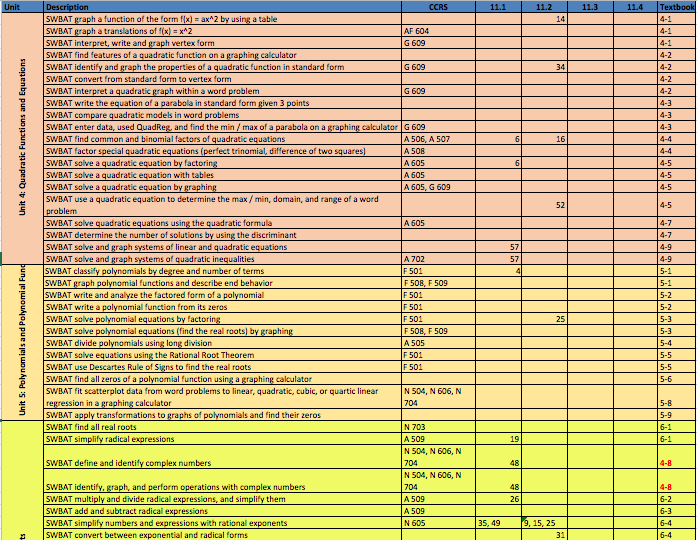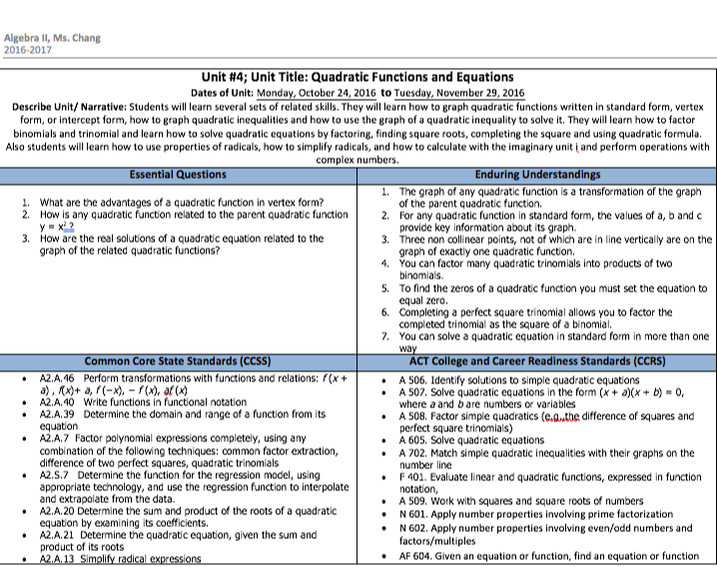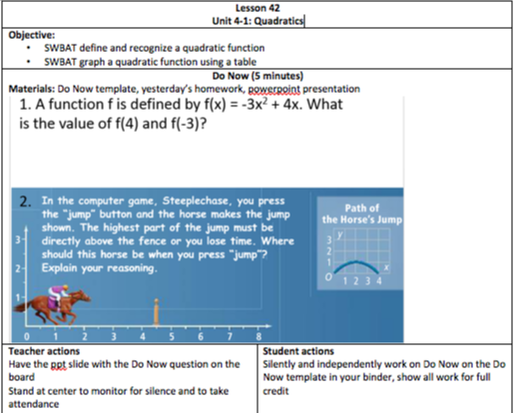Planning for Instruction
InTASC Standard 7: The teacher plans instruction that supports every student in meeting rigorous learning goals by drawing upon knowledge of content areas, curriculum, cross- disciplinary skills, and pedagogy, as well as knowledge of learners and the community context.
INTRODUCTION
Instructional planning is the foundation for effective instructional delivery and rigorous learning. My instructional planning consists of long-term planning, unit planning, and lesson planning. Together, they provide the framework, pacing, and standard of what learning should look and sound like in my classroom. My lessons, units, and year are backwards planned, stemming from my classroom vision and year-long goals.
I begin with long-term planning in order to outline an overview of topics I intend to cover in my Algebra II classes. My long-term plan is a hybrid of the standards provided by my classroom textbook, Pearson's Algebra 2 Common Core, and the College and Career Readiness Standards (CCRS). My long-term plan lists every daily objective that I intend to cover during the year, and its alignment to CCRS. In addition, my long-term plan maps every question on my students' quarterly ACT practice exams to objectives that will be covered in the course. Thus, I can view how and when each question type on the quarterly ACT exam will be explicitly reviewed in class.
After my long-term plan is drafted, I create unit plans. My units cover various function families such as linear, quadratic, polynomial, radical, rational, logarithmic, and periodic functions, as well as statistics, sequences and series. My unit plans consist of three major parts, the unit overview, the unit summative assessment exemplar, and the unit calendar. The unit overview contain unit descriptions, essential questions, enduring understandings, formative assessments, summative assessments, and list the Common Core State Standards, CCRS Standards, key concepts, vocabulary, and skills necessary for unit mastery. The unit summative assessment exemplar is created before the unit calendar in order to provide a roadmap for rigorous content. The unit calendar provides a pacing guide with a daily objective and reflection of culturally responsive teaching.
After my long-term plan and unit plans are created, I create my lesson plans. My lesson plans list the daily objective, Common Core State Standards, and related CCRS. The lesson plan also provides a guide for timing, necessary materials, teacher actions, student actions. I also implement an indexing system for my lesson plans, all students materials, and graded items, so that students and I have a common language for referencing work.
Please click on an image below to view how various planning methods and strategies are used in my classroom.
Instructional planning is the foundation for effective instructional delivery and rigorous learning. My instructional planning consists of long-term planning, unit planning, and lesson planning. Together, they provide the framework, pacing, and standard of what learning should look and sound like in my classroom. My lessons, units, and year are backwards planned, stemming from my classroom vision and year-long goals.
I begin with long-term planning in order to outline an overview of topics I intend to cover in my Algebra II classes. My long-term plan is a hybrid of the standards provided by my classroom textbook, Pearson's Algebra 2 Common Core, and the College and Career Readiness Standards (CCRS). My long-term plan lists every daily objective that I intend to cover during the year, and its alignment to CCRS. In addition, my long-term plan maps every question on my students' quarterly ACT practice exams to objectives that will be covered in the course. Thus, I can view how and when each question type on the quarterly ACT exam will be explicitly reviewed in class.
After my long-term plan is drafted, I create unit plans. My units cover various function families such as linear, quadratic, polynomial, radical, rational, logarithmic, and periodic functions, as well as statistics, sequences and series. My unit plans consist of three major parts, the unit overview, the unit summative assessment exemplar, and the unit calendar. The unit overview contain unit descriptions, essential questions, enduring understandings, formative assessments, summative assessments, and list the Common Core State Standards, CCRS Standards, key concepts, vocabulary, and skills necessary for unit mastery. The unit summative assessment exemplar is created before the unit calendar in order to provide a roadmap for rigorous content. The unit calendar provides a pacing guide with a daily objective and reflection of culturally responsive teaching.
After my long-term plan and unit plans are created, I create my lesson plans. My lesson plans list the daily objective, Common Core State Standards, and related CCRS. The lesson plan also provides a guide for timing, necessary materials, teacher actions, student actions. I also implement an indexing system for my lesson plans, all students materials, and graded items, so that students and I have a common language for referencing work.
Please click on an image below to view how various planning methods and strategies are used in my classroom.
Long-term Planning |
Unit Planning |
Lesson Planning |
CONCLUSION
Effective instructional planning is critical in helping every student meet rigorous learning goals. Backwards planning, collaboration, lesson evaluation and adjustment are cornerstones to effective instructional planning. I strive to use a wide range of evidence-based strategies, resources, media and technology resources to engage my students and increase the breadth and depth of learning.
Effective instructional planning is critical in helping every student meet rigorous learning goals. Backwards planning, collaboration, lesson evaluation and adjustment are cornerstones to effective instructional planning. I strive to use a wide range of evidence-based strategies, resources, media and technology resources to engage my students and increase the breadth and depth of learning.



